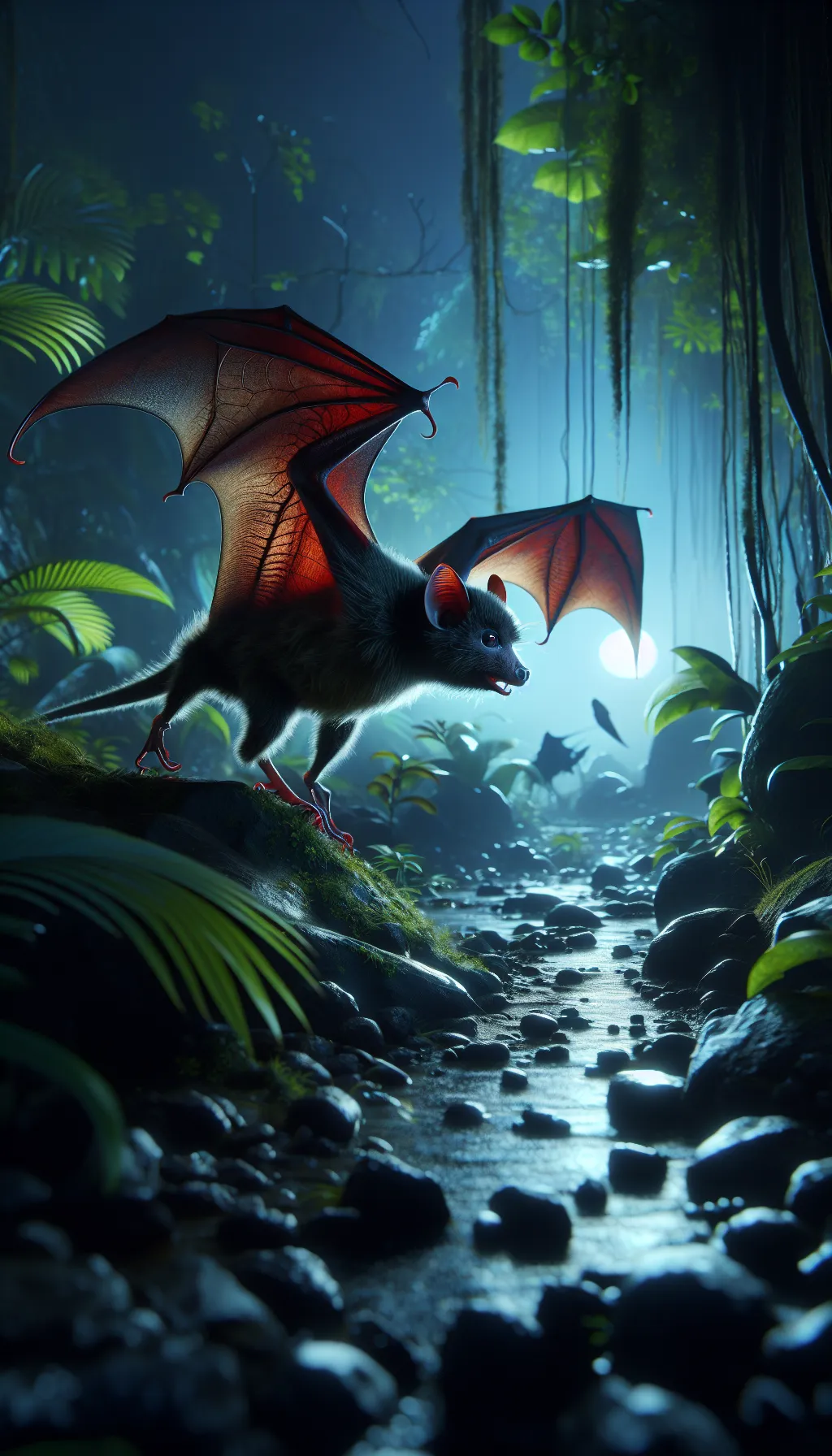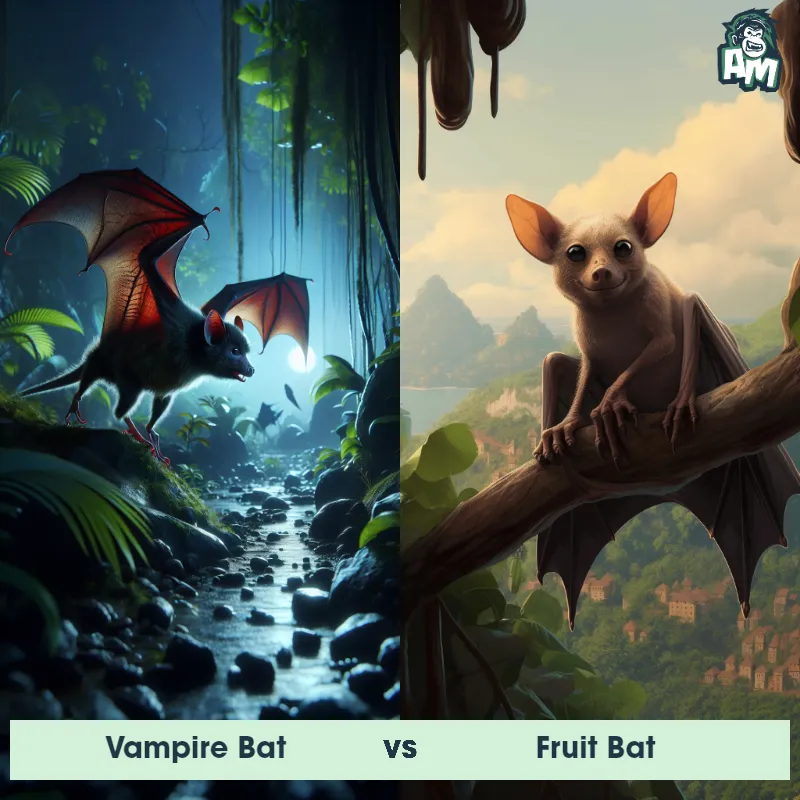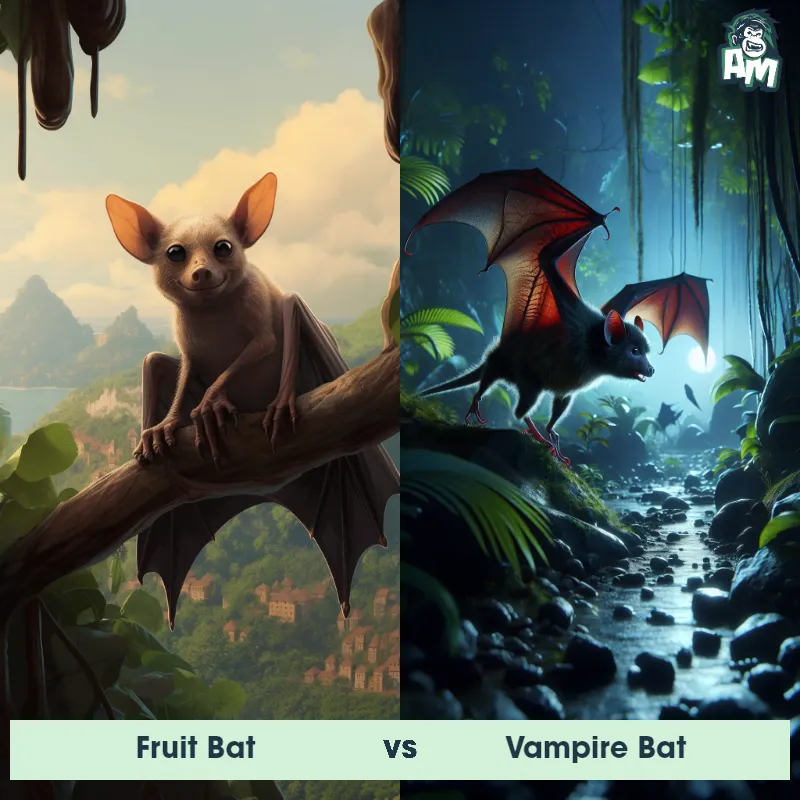The Vampire Bat
The Vampire Bat, scientifically known as Desmodus rotundus, is a small mammal found in the Americas. It is the only known mammal that feeds exclusively on blood, making it a hematophagous species. Vampire bats have a wingspan of around 7 to 9 inches and weigh about 1 ounce. They possess sharp incisors and elongated canines that allow them to make accurate, painless incisions on their prey's skin. Vampire bats often form small colonies, and they use echolocation to navigate in the dark during their nocturnal hunts.

| Vampire Bat | |
|---|---|
| Size | Wingspan: Up to 8 inches (20 cm); Body length: About 3 inches (7-9 cm) |
| Weight | About 0.5 to 1 ounce (16-32 grams) |
| Speed | 60 mph (97 km/h) |
| Key Strength | Agility and maneuverability in flight |
| Biggest Weakness | Vulnerable when grounded or in close quarters |
| Scientific Name | Desmodus rotundus |
| Family | Phyllostomidae |
| Habitat | Caves, hollow trees, and other sheltered areas |
| Geography | Central and South America |
| Diet | Blood from other animals (hematophagy) |
| Lifespan | 4 years - 9 years |

The Vampire Bat
The Vampire Bat, scientifically known as Desmodus rotundus, is a small mammal found in the Americas. It is the only known mammal that feeds exclusively on blood, making it a hematophagous species. Vampire bats have a wingspan of around 7 to 9 inches and weigh about 1 ounce. They possess sharp incisors and elongated canines that allow them to make accurate, painless incisions on their prey's skin. Vampire bats often form small colonies, and they use echolocation to navigate in the dark during their nocturnal hunts.
![[object Object] Gif](https://tenor.com/view/crawling-worlds-weirdest-bat-appreciation-day-checking-out-slowly-observing-gif-21096667.gif)
Fun Fact: Vampire bats have a unique method to locate their prey's veins stealthily, as they are attracted to the heat emitted from blood vessels, allowing them to find the most suitable spot for feeding without detection.
| Vampire Bat | |
|---|---|
| Size | Wingspan: Up to 8 inches (20 cm); Body length: About 3 inches (7-9 cm) |
| Weight | About 0.5 to 1 ounce (16-32 grams) |
| Speed | 60 mph (97 km/h) |
| Key Strength | Agility and maneuverability in flight |
| Biggest Weakness | Vulnerable when grounded or in close quarters |
| Scientific Name | Desmodus rotundus |
| Family | Phyllostomidae |
| Habitat | Caves, hollow trees, and other sheltered areas |
| Geography | Central and South America |
| Diet | Blood from other animals (hematophagy) |
| Lifespan | 4 years - 9 years |
Vampire Bat Matchups
We use AI to simulate matchups between the Vampire Bat and other animals. Our simulation considers size, strength, and natural predatory behaviors to determine the most likely outcome.

Can't find the Matchup you want?
Create Your Own MatchupVampire Bat: Diet, Predators, Aggression, and Defensive Behaviors
What do Vampire Bats eat?
Vampire Bats primarily feed on the blood of various animals, such as livestock like cattle, horses, and pigs. They have specialized teeth that allow them to make small incisions in the skin of their prey and lap up the blood that flows out. These bats are unique among bat species as they are the only ones that feed entirely on blood.
Do Vampire Bats have any predators?
Vampire Bats do have predators in the wild, such as birds of prey like owls and hawks, as well as larger bats, snakes, and carnivorous mammals like wild cats and raccoons. However, due to their nocturnal habits and ability to fly quickly, they are often able to evade predation successfully.
Are Vampire Bats aggressive?
Vampire Bats are not inherently aggressive towards humans or other animals. They generally prefer to avoid confrontation and only bite when they need to feed. However, if they feel threatened or cornered, they may exhibit defensive behaviors like hissing or biting to protect themselves.
Do Vampire Bats fight with each other?
Vampire Bats do engage in social interactions within their colonies, which can sometimes escalate into fights. These fights are usually over food sources or mating rights and involve displays of aggression like wing flapping, vocalizations, and even physical combat. Dominance hierarchies are established within colonies through these interactions.
How do Vampire Bats defend themselves?
Vampire Bats have several strategies to defend themselves from potential threats. They are adept fliers and can quickly escape from danger by taking to the air. Additionally, they may emit high-pitched vocalizations to startle predators or potential threats. If necessary, they can also use their sharp teeth to bite and defend themselves.
What is the biggest weakness of Vampire Bats in a fight?
The biggest weakness of Vampire Bats in a fight is their relatively small size and fragile nature compared to many of their predators. While they have sharp teeth and can defend themselves effectively in many situations, they are still vulnerable to larger and more powerful animals that may overpower them physically. Additionally, their dependence on blood as their sole food source can make them more susceptible to changes in prey availability.
Fun Fact: Contrary to popular belief, vampire bats do not actually suck blood. Instead, they make a small cut with their razor-sharp teeth and lap up the blood, which is kept flowing by a substance in their saliva that prevents clotting.
Fun Fact: In order to obtain their blood meal, vampire bats have a remarkable sharing behavior called "reciprocal altruism," where they regurgitate blood to nourish other colony members who were unable to feed, ensuring the survival of the whole group. This unique behavior reinforces the social bonds within a vampire bat colony.












